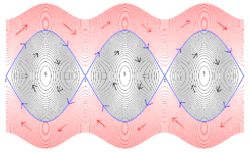Flow (mathematics)
 From HandWiki - Reading time: 8 min
From HandWiki - Reading time: 8 min

In mathematics, a flow formalizes the idea of the motion of particles in a fluid. Flows are ubiquitous in science, including engineering and physics. The notion of flow is basic to the study of ordinary differential equations. Informally, a flow may be viewed as a continuous motion of points over time. More formally, a flow is a group action of the real numbers on a set.
The idea of a vector flow, that is, the flow determined by a vector field, occurs in the areas of differential topology, Riemannian geometry and Lie groups. Specific examples of vector flows include the geodesic flow, the Hamiltonian flow, the Ricci flow, the mean curvature flow, and Anosov flows. Flows may also be defined for systems of random variables and stochastic processes, and occur in the study of ergodic dynamical systems. The most celebrated of these is perhaps the Bernoulli flow.
Formal definition
A flow on a set X is a group action of the additive group of real numbers on X. More explicitly, a flow is a mapping
such that, for all x ∈ X and all real numbers s and t,
It is customary to write φt(x) instead of φ(x, t), so that the equations above can be expressed as
Flows are usually required to be compatible with structures furnished on the set X. In particular, if X is equipped with a topology, then φ is usually required to be continuous. If X is equipped with a differentiable structure, then φ is usually required to be differentiable. In these cases the flow forms a one-parameter group of homeomorphisms and diffeomorphisms, respectively.
In certain situations one might also consider local flows, which are defined only in some subset
called the flow domain of φ. This is often the case with the flows of vector fields.
Alternative notations
It is very common in many fields, including engineering, physics and the study of differential equations, to use a notation that makes the flow implicit. Thus, x(t) is written for
In the case of a flow of a vector field V on a smooth manifold X, the flow is often denoted in such a way that its generator is made explicit. For example,
Orbits
Given x in X, the set
Examples
Algebraic equation
Let
Autonomous systems of ordinary differential equations
Let
Then
Time-dependent ordinary differential equations
In the case of time-dependent vector fields
Then
indeed satisfies the group law for the last variable:
One can see time-dependent flows of vector fields as special cases of time-independent ones by the following trick. Define
Then y(t) is the solution of the "time-independent" initial value problem
if and only if x(t) is the solution of the original time-dependent initial value problem. Furthermore, then the mapping φ is exactly the flow of the "time-independent" vector field G.
Flows of vector fields on manifolds
The flows of time-independent and time-dependent vector fields are defined on smooth manifolds exactly as they are defined on the Euclidean space
Formally: Let
Solutions of heat equation
Let Ω be a subdomain (bounded or not) of
with the following initial value condition u(0) = u0 in Ω .
The equation u = 0 on Γ × (0, T) corresponds to the Homogeneous Dirichlet boundary condition. The mathematical setting for this problem can be the semigroup approach. To use this tool, we introduce the unbounded operator ΔD defined on
(see the classical Sobolev spaces with
is the closure of the infinitely differentiable functions with compact support in Ω for the
For any
With this operator, the heat equation becomes
where exp(tΔD) is the (analytic) semigroup generated by ΔD.
Solutions of wave equation
Again, let Ω be a subdomain (bounded or not) of
with the following initial condition u(0) = u1,0 in Ω and
Using the same semigroup approach as in the case of the Heat Equation above. We write the wave equation as a first order in time partial differential equation by introducing the following unbounded operator,
with domain
We introduce the column vectors
(where
With these notions, the Wave Equation becomes
Thus, the flow corresponding to this equation is
where
Bernoulli flow
Ergodic dynamical systems, that is, systems exhibiting randomness, exhibit flows as well. The most celebrated of these is perhaps the Bernoulli flow. The Ornstein isomorphism theorem states that, for any given entropy H, there exists a flow φ(x, t), called the Bernoulli flow, such that the flow at time t = 1, i.e. φ(x, 1), is a Bernoulli shift.
Furthermore, this flow is unique, up to a constant rescaling of time. That is, if ψ(x, t), is another flow with the same entropy, then ψ(x, t) = φ(x, t), for some constant c. The notion of uniqueness and isomorphism here is that of the isomorphism of dynamical systems. Many dynamical systems, including Sinai's billiards and Anosov flows are isomorphic to Bernoulli shifts.
See also
References
- Hazewinkel, Michiel, ed. (2001), "Continuous flow", Encyclopedia of Mathematics, Springer Science+Business Media B.V. / Kluwer Academic Publishers, ISBN 978-1-55608-010-4, https://www.encyclopediaofmath.org/index.php?title=c/c025630
- Hazewinkel, Michiel, ed. (2001), "Measureable flow", Encyclopedia of Mathematics, Springer Science+Business Media B.V. / Kluwer Academic Publishers, ISBN 978-1-55608-010-4, https://www.encyclopediaofmath.org/index.php?title=m/m063190
- Hazewinkel, Michiel, ed. (2001), "Special flow", Encyclopedia of Mathematics, Springer Science+Business Media B.V. / Kluwer Academic Publishers, ISBN 978-1-55608-010-4, https://www.encyclopediaofmath.org/index.php?title=S/s086270
 |
21 views | Status: cached on July 16 2024 03:07:22
↧ Download this article as ZWI file
 KSF
KSF